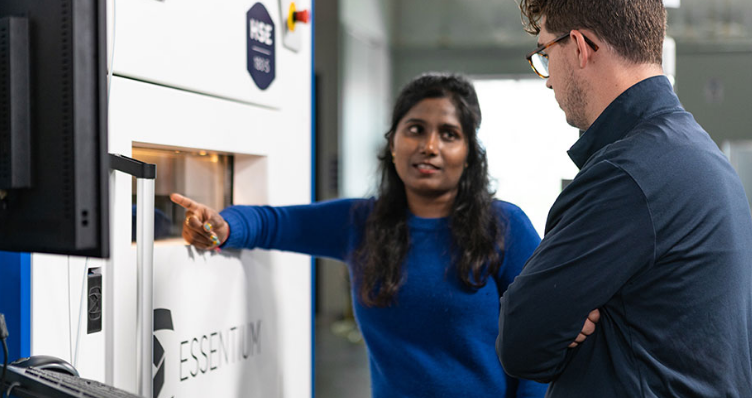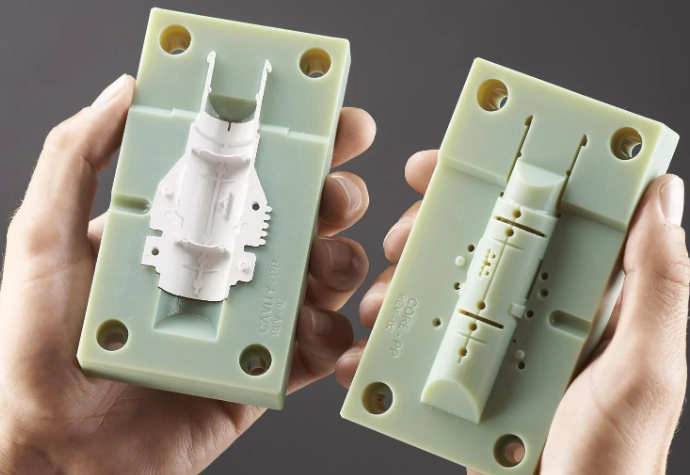3D printing competes well in customization and complex designs, while injection molding excels in large-scale production and cost-efficiency.
Defining Machine Speed in Injection Molding
Overview of Speed Parameters in Injection Molding Machines
In the context of injection molding, several speed parameters play crucial roles:

Injection Speed: This is the rate at which the plastic is injected into the mold. Typical injection speeds range from 60 to 300 mm/s. The chosen speed must align with the material’s properties to ensure optimal filling and part quality.
Clamping Speed: This parameter refers to how quickly the machine can open and close the mold. Speeds generally range from 500 to 800 mm/s. Faster clamping speeds can reduce cycle times but may increase wear on the machine.
Ejection Speed: The speed at which the finished part is ejected from the mold. This should be fast enough to maintain production efficiency, yet gentle to avoid damaging the part.
The Importance of Machine Speed in Production Efficiency
Machine speed directly impacts the efficiency of the injection molding process:
Reduced Cycle Time: Higher machine speeds can significantly decrease cycle times. For instance, increasing injection speed can shorten the filling phase of the molding cycle.
Energy Consumption: Speed settings influence the machine’s power consumption. Optimized speeds can lead to energy savings, directly affecting production costs.
Quality and Output Balance: Faster speeds can increase output but may compromise part quality. Achieving the right balance is key to maintaining high-quality standards while maximizing production efficiency.
Optimizing these speed parameters is essential for efficient, cost-effective, and high-quality injection molding production. Adjustments should be made considering the material, part design, and production requirements.
For more information on machine speed and its impact on injection molding, the Injection Molding Machine article on Wikipedia provides a comprehensive overview.
Key Factors Affecting Injection Molding Speed
Role of Machine Size and Clamping Force
The size of an injection molding machine and its clamping force are critical in determining the speed of the injection molding process.
Machine Size: Larger machines, capable of higher clamping forces, are generally slower in operation. For example, a 3000-ton machine may have a slower injection speed compared to a 500-ton machine due to the larger mass to be moved.
Clamping Force: The force used to keep the mold closed during injection. Higher clamping forces, while necessary for larger parts, can reduce the speed of the cycle. Machines with a clamping force of 2000 tons might operate slower than those with a force of 500 tons.
These factors must be carefully considered, as they directly impact production efficiency and part quality.
Impact of Material Properties on Molding Speed
Material properties significantly influence the speed at which molding can occur.
Viscosity: Materials with higher viscosity require slower injection speeds to fill the mold properly and avoid defects. For instance, Polypropylene, with lower viscosity, can be molded faster than a more viscous material like Polycarbonate.
Thermal Properties: Materials that cool down rapidly, such as certain grades of Nylon, may allow for faster cycle times as less cooling time is required.
Understanding these material properties is crucial for setting the optimal molding speeds, balancing efficiency with the quality of the final product.
Adjusting the injection molding speed based on machine size, clamping force, and material properties is key to efficient production. Proper calibration ensures high-quality parts are produced in the most time-efficient manner.
For more in-depth knowledge about how these factors impact the injection molding process, refer to the Injection Molding Material Properties section on Wikipedia.
Optimizing Injection Speed for Different Applications
Speed Considerations for Precision Parts
| Factor | Impact on Injection Speed | Description |
|---|---|---|
| Complexity of Design | Requires Slower Speeds | Precision parts often have intricate geometries that need slower injection speeds to accurately capture details. |
| Material Selection | Varies Based on Material | High-performance materials used for precision parts may require specific speed settings to maintain quality. |
| Tolerance Levels | Slower Speeds for Tight Tolerances | Achieving tight tolerances in precision parts necessitates controlled and slower injection speeds. |
Adjusting Speed for Large Volume Production
| Factor | Impact on Injection Speed | Description |
|---|---|---|
| Part Complexity | Higher Speeds for Simpler Designs | Large volume parts are often simpler, allowing for faster injection speeds without compromising quality. |
| Production Targets | Higher Speeds to Meet Demand | To meet high production demands, injection speeds are increased, reducing cycle times. |
| Energy Efficiency | Balance Speed with Energy Use | While higher speeds increase output, they must be balanced with energy consumption to optimize cost-effectiveness. |
Balancing injection speed is essential for both precision part manufacturing and large volume production. For precision parts, slower speeds ensure accuracy and detail, while for large volume production, higher speeds are necessary to meet production targets.
For further details on optimizing injection speeds, the Injection Molding Process Optimization section on Wikipedia provides valuable insights.
Machine Speed and Its Effect on Part Quality
Balancing Speed with Part Integrity and Aesthetics
The injection speed must be carefully balanced to maintain the integrity and aesthetics of the molded parts:

Optimal Speed for Quality: Finding the right speed is crucial. Too fast, and it can lead to defects; too slow, and it might cause incomplete filling or prolonged cycle times.
Impact on Aesthetics: Speed affects the surface finish of the part. A speed that’s too high can create surface defects, while a slower speed might produce a smoother finish.
Consistency in Production: Maintaining a consistent speed ensures uniform quality across all produced parts, crucial in large-scale production runs.
Speed-Related Defects in Injection Molded Parts
Inappropriate speeds during the injection molding process can lead to various defects:
Short Shots: Caused by too low a speed, resulting in incomplete filling of the mold.
Warping and Sink Marks: Occur when the speed is not adequately balanced with the cooling time, leading to uneven cooling and part deformation.
Burn Marks and Flash: High speeds can generate excessive friction and heat, causing burn marks. Excessive speed can also lead to flash, where material seeps out of the mold cavity.
Adjusting the injection speed is a delicate process that directly influences the cost, efficiency, and quality of production. A well-optimized speed setting not only ensures high-quality parts but also contributes to the overall sustainability and profitability of the molding operation.
For more detailed information on how machine speed affects part quality in injection molding, visit the Injection Molding Defects section on Wikipedia.




